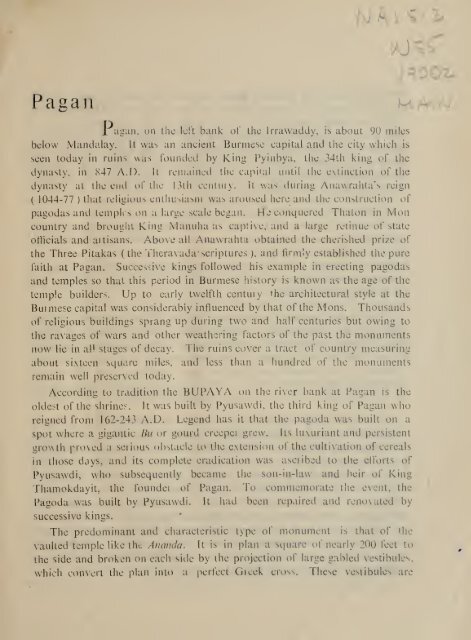Create successful ePaper yourself
Turn your PDF publications into a flip-book with our unique Google optimized e-Paper software.
V<br />
<strong>Pagan</strong><br />
02*<br />
lagan, on the left bank o\' the Irrawaddy, is about 90 miles<br />
below Mandalay. It was an ancient Burmese capital and the city which is<br />
seen today in ruins was founded by King Pyinbya, the 34th king <strong>of</strong> the<br />
dynasty, in 847 A.D. li remained the capital until the extinction <strong>of</strong> the<br />
dynast>' at the end <strong>of</strong> the 13th centuiy. it was dining Anawrahta's reign<br />
( 1044-77 ) that religious enthusiasm was aroused here and the construction <strong>of</strong><br />
pagodas and temples on a large scale began. He conquered Thaion in Mon<br />
country and brought King Manulia as captive, and a large retinue <strong>of</strong> state<br />
<strong>of</strong>ficials and artisans. Above all Anawrahta obtained the cherished prize <strong>of</strong><br />
the Three Pitakas ( the Theravada* scriptures ), and firmlj established the pure<br />
faith at <strong>Pagan</strong>. Successive kings followed his example in erecting pagodas<br />
and temples so that this period in Burmese history is known as the age <strong>of</strong> the<br />
temple builders. Up to early twelfth centuiy the architectural style at the<br />
Burmese capital was considerably influenced by that <strong>of</strong> the Mons. Thousands<br />
o\~ religious buildings sprang up during two and half centuries but owing to<br />
the ravages <strong>of</strong> wars and other weathering factors o\" the past the monuments<br />
now lie in all stages <strong>of</strong> decay. The ruins cover a tract o\' country measuring<br />
about sixteen square miles, and less than a hundred o[^ the monuments<br />
remain well preserved today.<br />
According to tradition ihc BUPAYA n\\ the ri\er bank at <strong>Pagan</strong> is the<br />
oldest <strong>of</strong> the shrines. It was built by Pyusawdi. the third king <strong>of</strong> <strong>Pagan</strong>, who<br />
reigned from 162-243 A.D. Legend has it that the pagoda was built on a<br />
spot where a gigantic Bu or gourd creepci grew. Its luxuriant and persistent<br />
growth proved a serious obstacle to the extension <strong>of</strong> the cultivation <strong>of</strong> cereals<br />
in those days, and its complete eradication was ascribed to the efforts<br />
Pyusawdi, who subsequently became the son-in-law and heir <strong>of</strong> !\<br />
Thamokdayit, the foundei <strong>of</strong> <strong>Pagan</strong>. To commemorate the event, the<br />
Pagoda was built by Pyusawdi. It had been repaired and renovated by<br />
successive kings.<br />
The predominant and characteristic type <strong>of</strong> monument is that <strong>of</strong><br />
Vaulted temple like the Ananda. It is in plan a square <strong>of</strong> nearly 200 feet to<br />
the side and broken on each side by the projection <strong>of</strong> large gabled vestibules,<br />
which convert the plan into a perfect Cutck cross. These \estibules are<br />
^\'

















